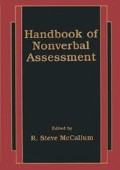Abstract
The Cattell-Horn-Carroll (CHC) Cross-Battery approach, originally known as the Gf-Gc Cross-Battery model of assessment, has been defined as “a time efficient method of intellectual assessment that allows practitioners to measure validly a wider range (or a more in-depth but selective range) of cognitive abilities than that represented by any one intelligence battery in a way consistent with contemporary psychometric theory and research on the structure of intelligence” (McGrew & Flanagan, 1998, p. 357). The CHC Cross-Battery approach provides at least two unique advantages: (a) data gathered both within and across test batteries can be interpreted theoretically and empirically within meaningful patterns; and (b) cognitive test data lead to examination of empirically validated links between specific cognitive abilities and specific academic areas (Flanagan & Ortiz, 2001). The approach provides practitioners with a classification system of cognitive abilities; existing cognitive tests can be evaluated according to the model, that is, subcomponents/subtests can be described based on their ability to assess cognitive abilities within the CHC model.
Access this chapter
Tax calculation will be finalised at checkout
Purchases are for personal use only
Preview
Unable to display preview. Download preview PDF.
References
Bowers, P., & Wolf, M. (1993). Theoretical links among naming speed, precise timing mechanisms, and orthographic skill in dyslexia. Reading and Writing, 5, 69–86.
Bracken, B. A., & McCallum, R. S. (1998). Universal nonverbal intelligence test. Itasca, IL:Riverside.
Brown, L., Sherbenou, R. J., & Johnson, S. K. (1997). Test of nonverbal intelligence (3rd ed.). Austin, TX: Pro-Ed.
Carroll, J. B. (1993). Human cognitive abilities: A survey of factor-analytic studies. Cambridge: Cambridge University Press.
Cattell, R. B. (1941). Some theoretical issues in adult intelligence testing. Psychological Bulletin, 38,592.
Cattell, R. B. (1957). Personality and motivation structure and measurement. New York: World Book.
Cattell, R. B. (1963). Theory of crystallized and fluid intelligence. Journal of Educational Psychology, 54, 1–22.
Dunn, L. M., Dunn, L. M., & Williams, K. T. (1997). Peabody picture vocabulary test—third edition. Circle Pines, MN: American Guidance Services.
Fell Greene, J. (2001) Language! Longmont, CO: Sopris West.
Flanagan, D. P., & McGrew, K. S. (1997). A cross-battery approach to assessing and interpreting cognitive abilities: Narrowing the gap between practice and cognitive science. In D. P. Flanagan, J. L. Genshaft, & P. L. Harrison (Eds.), Contemporary intellectual assess-ment: Theories, tests, and issues (pp. 314–325). New York: Guilford.
Flanagan, D. P., & Ortiz, S. (2001). Essentials of cross-battery assessment. New York: Wiley.
Floyd, R. G. (2002). The Cattell-Horn-Carroll (CHC) cross-battery approach: Recommendations for school psychologists. Communique, 30(5), 10–14.
Gustafsson, J. E., & Undheim, J. O. (1996). Individual differences in cognitive functions. In C. D. Berliner & R. D. Cabfee (Eds.), Handbook of educational psychology. New York: Macmillan.
Hammill, D. D., Pearson, N. A., & Wiederholt, J. L. (1996). Comprehensive test of nonverbal intelligence. Austin, TX: Pro-Ed.
Horn, J. L. (1965). Fluid and crystallized intelligence: A factor analytic and developmental study of the structure among primary mental abilities. Unpublished doctoral dissertation, University of Illinois, Champaign.
Horn, J. L. (1968). Organization of abilities and the development of intelligence. Psychological Review, 75, 242–259.
Horn, J. L. (1976). Human abilities: A review of research and theory in the early 1970s. Annual Review of Psychology, 27, 437–485.
Horn, J. L. (1985). Remodeling old theories of intelligence: Gf-Gc theory. In B. B. Wolman (Ed.), Handook of intelligence (pp. 267–300). New York: Wiley.
Horn, J. L. (1988). Thinking about human abilities. In J. R. Nesselroade & R. B. Cattell (Eds.), Handbook of multivariate psychology (rev. ed., pp. 645–685). New York: Wiley.
Horn, J. L. (1991). Measurement of intellectual capabilities: A review of theory. In K. S. McGrew, J. K. Werder, & R. W. Woodcock (Eds.), Woodcock-Johnson technical manual (pp. 197–232). Chicago: Riverside.
Kellogg, C. E., & Morton, N. W. (1999). Beta III manual. San Antonio, TX: Psychological Corporation.
Mather, N. (1991). An instructional guide to the Woodcock Johnson psychoeducationai battery—revised. Brandon, VT: Clinical Psychology.
McGrew, K. S. (1997). Analysis of the major intelligence batteries according to a proposed comprehensive Gf-Gc framework. In D. P. Flanagan, J. L. Genshaft, & P. L. Harrison (Eds.), Contemporary intellectual assessment: Theories, tests,and issues (pp.151–180). New York: Guilford.
McGrew, K. S., & Flanagan, D. P. (1998). The intelligence test desk reference (ITDR): Gf-Gc cross-battery assessment. Boston: Allyn & Bacon.
Naglieri, J. A. (1985a). Matrix analogies test-expanded form. San Antonio, TX: Psychological Corporation.
Naglieri, J. A. (1985b). Matrix analogies test-short form. San Antonio, TX: Psychological Corporation.
Naglieri, J. A. (1996a). Naglieri nonverbal ability test. San Antonio, TX: Psychological Corporation.
Naglieri, J. A. (1996b). NNAT multilevel technical manual. San Antonio, TX: Harcourt Brace Educational Measurement.
Naglieri, J. A. (1997). General ability measure for adults. Minneapolis, MN: NCS Assessments.
Ortiz, S. O., & Flanagan, D. P. (2002a). Cross-battery assessment revisited: Some cautions concerning “some cautions” part I. Communique, 30(7), 32–34.
Ortiz, S. O., & Flanagan, D. P. (2002b). Some cautions concerning “some cautions concerning cross-battery assessment” part II. Communique, 30(8), 36–38.
Raven, J. C. (1938). Progressive matrices: A perceptual test of intelligence. San Antonio, TX: Psychological Corporation.
Roid, G. H., & Miller, L. J. (1997). The Leiter International Performance Scale-Revised edition Wood Dale, IL: Stoelting.
Slingerland, B. H. (1971). A multisensory approach to language arts for specific language disability children. Cambridge, MA: Educator’s Publishing Services, Inc.
Watkins, M. W., Youngstrom, E. A., & Glutting, J. J. (2002). Some cautions concerning cross-battery assessment. Communique, 30(5), 16–20.
Woodcock, R. W. (1994). Measures of fluid and crystallized intelligence. In R. J. Sternberg (Ed.), The encyclopedia of intelligence (pp. 452–456). New York: Macmillan.
Author information
Authors and Affiliations
Editor information
Editors and Affiliations
Rights and permissions
Copyright information
© 2003 Springer Science+Business Media New York
About this chapter
Cite this chapter
Wilhoit, B.E., McCallum, R.S. (2003). Cross-Battery Assessment of Nonverbal Cognitive Ability. In: McCallum, R.S. (eds) Handbook of Nonverbal Assessment. Springer, Boston, MA. https://doi.org/10.1007/978-1-4615-0153-4_4
Download citation
DOI: https://doi.org/10.1007/978-1-4615-0153-4_4
Publisher Name: Springer, Boston, MA
Print ISBN: 978-1-4613-4945-7
Online ISBN: 978-1-4615-0153-4
eBook Packages: Springer Book Archive

